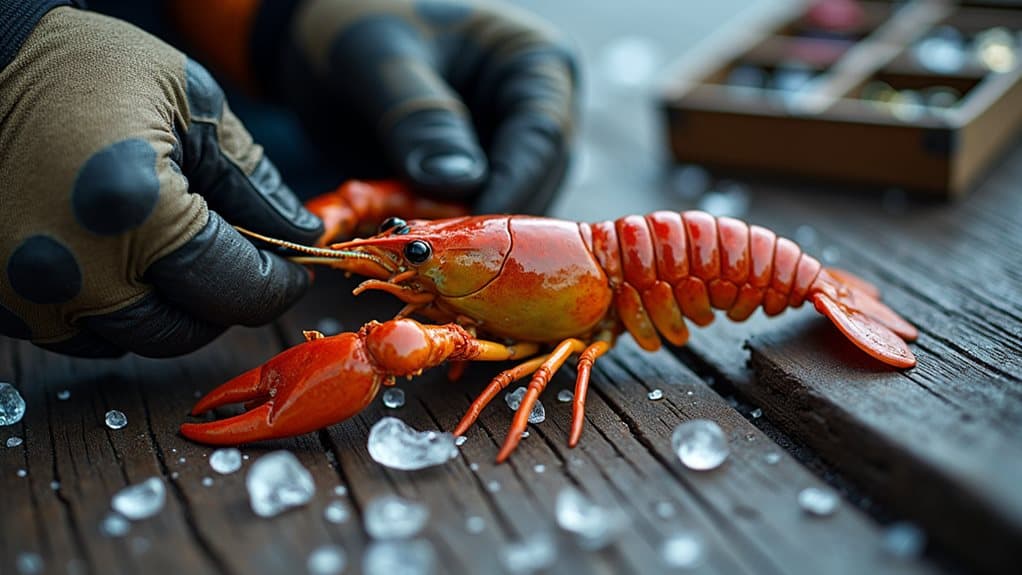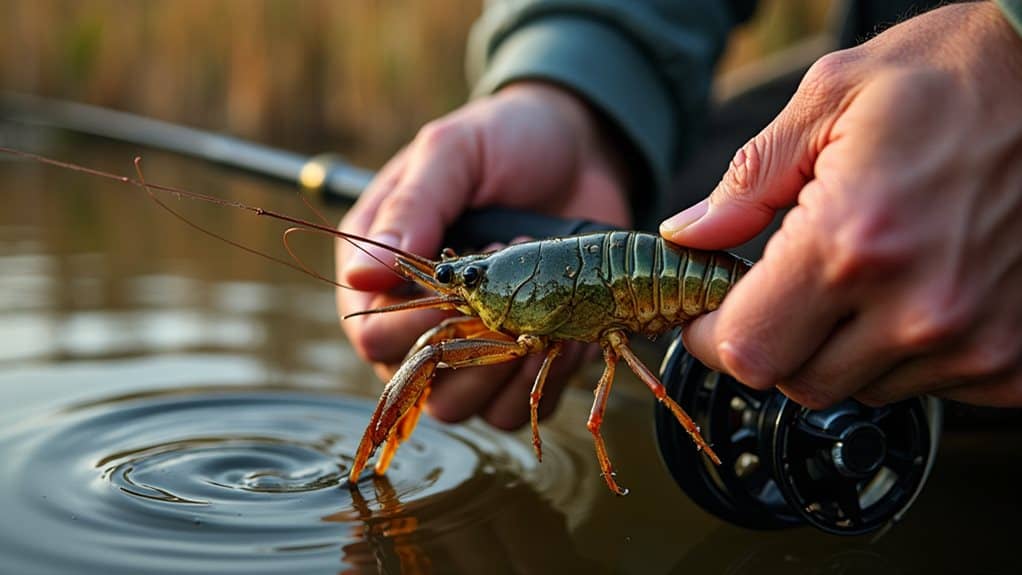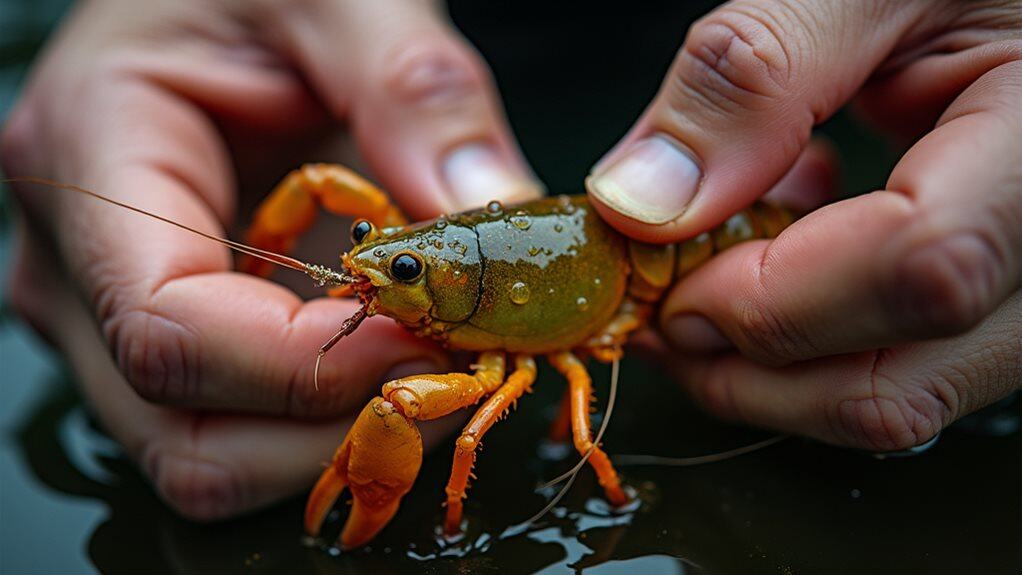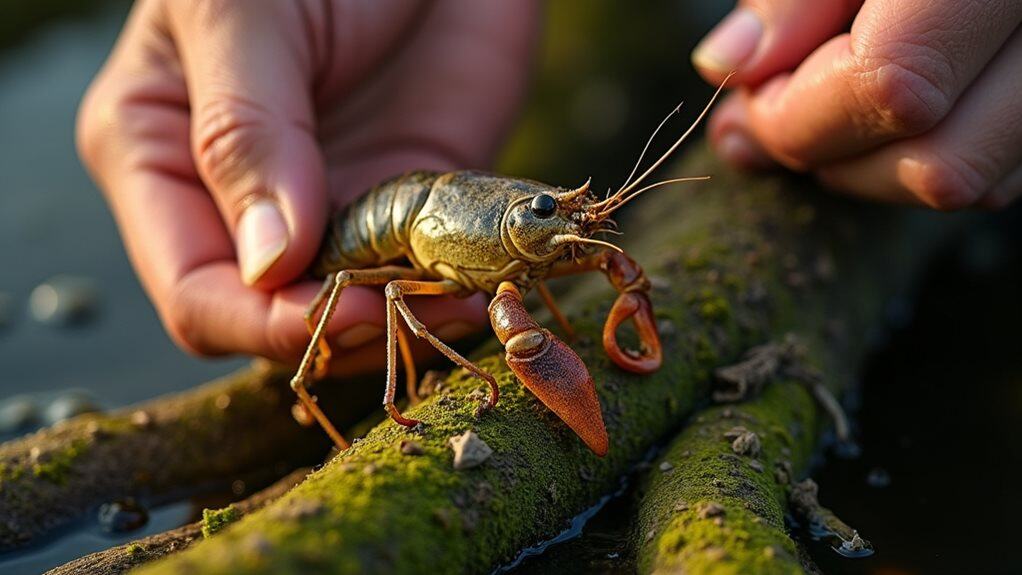To hook a live crawfish, you’ll want to secure its claws with rubber bands first, then choose between two effective placements. Insert your size #4 to 1/0 hook through the nose for natural swimming movement, or position it through the tail section for a more vulnerable appearance that triggers predator strikes. Use medium-weight tackle with 10-15 lb test line, and remember that crawfish strikes are often subtle rather than aggressive. Perfect these fundamentals to access advanced techniques that’ll dramatically increase your success rate.
TLDR
- Secure crawfish claws with rubber bands and grasp firmly behind claws to prevent pinching during handling.
- Use medium hooks sized #4 to 1/0 with wide gaps for better hooksets on 2-4 inch crawfish.
- Insert hook through the nose for natural movement or through the tail for vulnerable appearance to predators.
- Choose appropriate rod length of 6’6″ to 7’4″ with matching line weight for target fish species.
- Watch for subtle strikes like slight ticks or line movement rather than aggressive takes when fishing crawfish.
Essential Safety Measures and Crawfish Preparation

Before you can effectively use crawfish as bait, you’ll need to prioritize safety and proper preparation to guarantee both your wellbeing and the quality of your fishing experience.
Always wear gloves when handling crawfish, as their claws pinch unpredictably. Grasp them firmly behind the claws, and select only active, healthy specimens with intact shells for ideal bait performance. Remember that you can collect up to 150 pounds of crawfish per day for your fishing needs, which provides plenty of bait for extended fishing trips. Additionally, ensuring safety measures like wearing personal flotation devices is crucial when engaging in water activities.
Selecting the Right Hook Size and Fishing Gear
Success with live crawfish bait hinges on selecting the proper hook size and gear combination that complements your target species and fishing conditions.
For typical 2-4 inch crawfish, you’ll want medium hooks ranging from size #4 to 1/0. Using a good quality rod and reel combo can enhance your fishing experience and ensure that you have the right gear performance for optimal results.
Choose larger 1/0-3/0 hooks when targeting bass or catfish, while smaller #4-#1 hooks work better for panfish and trout. Remember that in the smaller hook range, larger numbers indicate smaller hooks, so a #4 hook is actually smaller than a #1 hook.
Choosing the Proper Rod and Line Setup

When you’re fishing with live crawfish, your rod and line setup directly impacts your success in detecting subtle bites and landing fish effectively.
You’ll need to balance rod length and action based on your fishing environment, whether you’re casting from shore or working close quarters from a boat.
Your line weight selection must complement your rod choice while providing the right combination of sensitivity and strength for the species you’re targeting. Additionally, consider using a fish finder technology to enhance your ability to locate fish while using live bait effectively.
Rod Length and Action
The foundation of successful crawfish fishing lies in selecting a rod with the appropriate length and action for your specific fishing environment and target species.
You’ll want a 6’6″ to 7’4″ medium-action rod for most situations, as it provides excellent sensitivity for detecting subtle bites while offering enough backbone to handle larger fish that often target live crawfish.
Line Weight Selection
After selecting your rod, you’ll need to match it with the appropriate line weight to maximize your live crawfish presentation and hooking success.
For finesse fishing targeting smaller bass and panfish, choose 4-10 lb braided line, which offers excellent sensitivity for detecting subtle bites.
When pursuing larger bass or fishing heavy cover, increase to 10-15 lb test for added strength and durability.
Understanding Carolina Rigs and Weighted Presentations
Although various rigging methods exist for presenting live crawfish, Carolina rigs offer one of the most effective weighted presentations for targeting bottom-feeding species like bass, catfish, and walleye.
This setup uses a bullet or egg sinker ahead of your bait, maintaining consistent bottom contact while allowing the crawfish natural movement through a fluorocarbon leader. Additionally, using a portable air conditioner can enhance your fishing experience by keeping you cool and comfortable during hot days on the water.
Step-by-Step Crawfish Rigging Process

Before you can present your crawfish to waiting bass, you’ll need to secure it properly and choose the right hook placement for your fishing conditions.
Start by gently placing rubber bands around the crawfish’s claws to prevent it from pinching you and to keep it from grabbing onto structure underwater.
The key to successful crawfish rigging lies in understanding where to position your hook based on the technique you’re using, whether that’s through the nose for a Texas rig or through the middle section for a wacky presentation.
Secure Crawfish With Bands
When handling live crawfish for fishing, securing the pincers with rubber bands serves as your first line of defense against painful pinches while preserving the bait’s natural appeal.
Place a small rubber band over both pincers near the claw base, ensuring it’s snug but not overly tight. This prevents injury while maintaining the crawfish’s mobility and effectiveness.
Hook Placement Techniques
With your crawfish properly secured, the next step involves selecting the right hook and determining where to place it on your bait.
Choose a size-appropriate hook with a wide gap for better hooksets.
You’ll have two primary placement options: through the nose for maximum mobility or through the tail’s meaty section for increased retention and control.
Proper Hook Placement and Positioning Techniques
Becoming proficient in proper hook placement changes live crawfish from simple bait into irresistible targets that bass can’t refuse.
Insert your hook through the nose to preserve natural mobility, positioning it toward the tail for ideal strike angles.
Alternatively, hook through the tail near the chest to restrict movement, creating a vulnerable presentation that crawling predators find irresistible.
Casting Methods for Live Crawfish Bait

Once you’ve properly hooked your live crawfish, you’ll need to perfect gentle casting techniques that preserve the bait’s natural movement and liveliness.
Your casting approach should focus on smooth, controlled motions using a light action rod, avoiding excessive force that could damage or kill your crawfish before it reaches the water.
The goal is to present your bait naturally along the bottom where crawfish typically move, allowing it to maintain its lifelike action that attracts bass and catfish.
Gentle Casting Techniques
Two critical factors determine whether your live crawfish remains active and effective during the cast: the gentleness of your motion and the speed at which you execute it.
You’ll want to use smooth, controlled movements rather than jerky motions that could dislodge or injure your bait. A deliberate, steady casting technique preserves the crawfish’s integrity and natural presentation.
Natural Bottom Presentation
Your casting technique sets the stage for success, but achieving a natural bottom presentation requires specific methods that mimic how crawfish actually behave in their underwater environment.
Let your live crawfish sink completely to the bottom before starting retrieval.
Work the bait with short, slow pulls along the bottom, followed by pauses that simulate natural scurrying movements.
Effective Retrieval and Presentation Strategies
While mastering the art of hooking live crawfish is essential, understanding how to effectively retrieve and present your bait determines whether you’ll experience fishing success or frustration.
Use slow, steady retrieves mimicking natural crawfish movement, incorporating occasional quick jerks and pauses to replicate defensive behavior.
Position your bait near bottom structures like rocks and logs where fish typically forage.
Prime Locations and Target Species

Finding productive waters where crawfish thrive naturally puts you ahead of the game before you even wet your line.
Target rocky bottoms in clear, fresh water less than twenty feet deep, focusing on slower-moving areas near river banks and islands.
Louisiana’s Atchafalaya Basin, Georgia’s Crawfish Creek, and Utah’s river systems offer excellent opportunities for harvesting strong crawfish species.
Recognizing Strike Patterns and Hookup Success
Since bass strikes on crawfish baits are often remarkably subtle compared to other presentations, developing a keen sense for detecting these delicate takes becomes the difference between a successful day on the water and heading home empty-handed.
You’ll need to watch for slight ticks, pauses, or line movement rather than aggressive strikes, then set the hook immediately upon detection.
Maintenance Tips and Troubleshooting Common Issues

Keeping your live crawfish healthy and active requires consistent attention to their basic needs, but even experienced anglers encounter common problems that can quickly turn premium bait into expensive fish food.
Monitor water clarity daily, remove dead crawfish immediately, and maintain proper aeration.
Cloudy water signals overfeeding, while sudden deaths indicate temperature shock or poor water quality.
Final Note
You’ve now become proficient in the fundamentals of hooking live crawfish for successful fishing. Remember to handle your bait carefully, match your hook size to the crawfish, and present it naturally near bottom structure. Watch for subtle strikes and set your hook firmly when you feel that telltale tap. With practice, you’ll consistently attract bass, catfish, and other game fish. Keep your crawfish lively, stay patient, and you’ll see improved results on the water.




